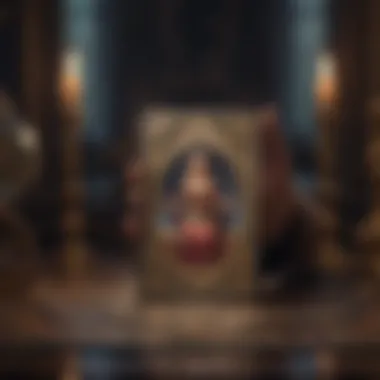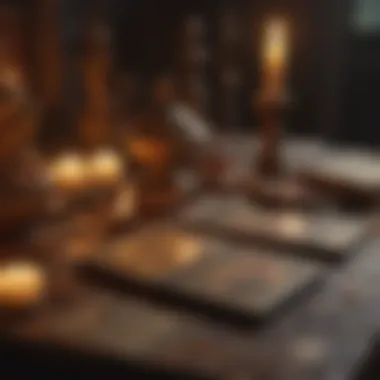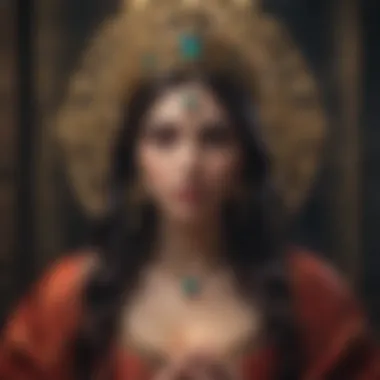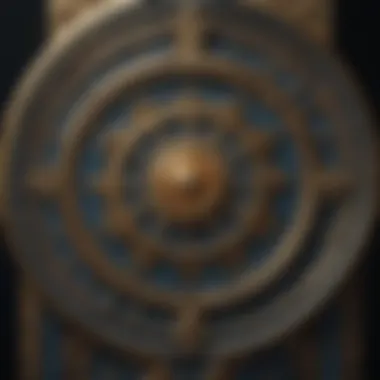Ethereal Visions Illuminated: Insights into Tarot Reading


Intro
Tarot reading has intrigued humanity for centuries. It serves not only as a means of divination but also as a profound tool for self-exploration and spiritual growth. In this comprehensive exploration, we will unveil the layers within tarot, from its historical roots to its contemporary applications. We will also suitably analyze its role as a bridge to personal insight and intuition.
By examining the intersection of tarot with spirituality and the importance of interpretation techniques, we can grasp the essence of this esoteric practice. We will engage with critiques surrounding tarot while emphasizing its capacity for deep introspection and understanding.
This article aims to appeal to astrologers, tarologists, and esotericists, sustaining a rich narrative that enlightens and informs readers of varied backgrounds. As we embark on this journey, our first point of exploration will be the connection between tarot readings and the astrological zodiac signs.
Zodiac Sign Overview
General Traits and Characteristics
Zodiac signs and tarot intertwine through shared archetypes. Each sign in the zodiac has distinct traits and characteristics that can illuminate tarot interpretations. For example, Aries may signify boldness and action, while Pisces often embodies intuition and emotion. Understanding these qualities enriches the context of tarot readings.
Elemental Associations
Each zodiac sign corresponds with one of the four classical elements—Fire, Earth, Air, or Water. These elemental associations play a significant role in understanding the nature of tarot cards positioned for different signs:
- Fire: Aries, Leo, Sagittarius - represent passion and energy.
- Earth: Taurus, Virgo, Capricorn - signify stability and practicality.
- Air: Gemini, Libra, Aquarius - embody intellect and communication.
- Water: Cancer, Scorpio, Pisces - illustrate emotion and intuition.
Understanding these connections can sharpen a reader's interpretation of a tarot spread.
Ruling Planets
Astrological signs are also influenced by their ruling planets. These celestial bodies affect personalities and can guide tarot readings. For instance, Venus rules Taurus, infusing themes of love and beauty. Knowing a sign's ruling planet aids in a more nuanced interpretation of tarot cards relating to that sign's energy.
“Tarot invites one to reflect on their personal relationship with the universe, connecting the insights of astrology to the narrative unfolding in a tarot reading.”
Compatibility Analysis
Relationship Dynamics with Other Zodiac Signs
Compatibility between zodiac signs can offer insight into the interactions within tarot readings. For example, a Leo may naturally align with another fire sign like Sagittarius, while an Earth sign such as Taurus may experience harmony with Virgo. Complex dynamics can be analyzed through tarot, allowing for richer relational insights.
Friendship Compatibility
In friendships, some zodiac couples enhance each other’s strengths through compatibility, while others may present challenges. Tarot readings that consider these dynamics can guide individuals toward better understanding of their friendships.
Family and Workplace Relationships
Tarot can also illuminate family and workplace interactions based on zodiac compatibility. Different signs react uniquely to pressures and conflicts, which can be interpreted through tarot readings. Understanding these relationships fosters dynamic communication.
Astrological Influences
How Current Celestial Events Affect Each Sign
Astrological events, such as retrogrades or eclipses, can have distinct impacts on each zodiac sign. Similarly, tarot readings conducted during these periods may resonate with shifting energies and prompt changes in self-understanding.
Monthly and Weekly Influences
Reading tarot within the context of monthly or weekly astrological insights can enhance the understanding of ongoing challenges or growth opportunities. This approach allows readers to align their interpretations with the ebb and flow of celestial influences.
Personal Growth Opportunities Through Astrology
Each astrological season brings unique growth opportunities that can be explored through tarot. A person may be encouraged to confront fears or embrace new beginnings aligned with their sign's traits and current astrological transits.


In this unfolding narrative about tarot, we endeavor to bridge personal insights and universal energies, guiding readers through a comprehensive understanding of this ancient practice. The exploration continues with an examination of how tarot can bring forth significant pathways to self-discovery.
Understanding Tarot
Understanding Tarot is crucial for anyone looking to explore the deeper meanings and workings of this practice. It serves as the foundation from which one can build an informed, intuitive approach to readings. Recognizing the historical context, structure, and purposes of tarot has distinct benefits. For instance, it not only enriches one’s appreciation for the art but also enhances the accuracy and depth of readings.
Origins of Tarot
The origins of tarot can be traced back to 15th century Europe, where playing cards were primarily used for leisure. Researchers believe that its roots are likely intertwined with ancient rituals and games from various cultures. As times progressed, tarot decks evolved, incorporating symbolic imagery that expressed complex spiritual and philosophical themes.
In the 18th century, tarot gained popularity within esoteric circles. Scholars and mystics began to associate the cards with mystical meanings and divination practices. This evolution significantly shaped how tarot is perceived today, particularly as a tool for self-reflection and guidance.
Structure of a Tarot Deck
A standard tarot deck consists of 78 cards, divided into two main categories: the Major Arcana and the Minor Arcana. This structure is significant, as it speaks to the dual aspects of life and spirituality.
Major Arcana
The Major Arcana consists of 22 cards, each of which represents significant life events or spiritual lessons. These cards are often viewed as the backbone of a reading, encapsulating profound insights and major influences. A key characteristic of the Major Arcana is its ability to highlight pivotal moments in one’s life or spiritual journey. For example, cards like The Fool signify new beginnings, while The World represents completion and fulfillment.
This segment of the deck is beneficial as it can lead to deeper introspection. Its unique feature lies within the archetypal symbols, which resonate universally and offer insights into personal circumstances. However, the Major Arcana may sometimes overshadow the subtle lessons found in the Minor Arcana.
Minor Arcana
In contrast, the Minor Arcana consists of 56 cards divided into four suits: Cups, Pentacles, Swords, and Wands. These cards typically reflect day-to-day experiences and challenges, offering insight into practical matters. The key characteristic of the Minor Arcana is its emphasis on the everyday aspects of life, making it a popular choice for those seeking guidance in routine situations.
The unique feature of the Minor Arcana is its diverse range of imagery and meanings, allowing for a nuanced reading that can adapt to various contexts. While it may not carry the same weight as the Major Arcana, the Minor Arcana plays a critical role in painting a complete picture, helping individuals address the challenges that arise in their lives.
Tarot and Divination
Tarot and divination are intertwined concepts. Tarot serves as a form of divination, providing insights into the past, present, and future. Through the interpretation of cards, practitioners aim to gain clarity on various life situations. Understanding how tarot embodies the principles of divination can enrich one's reading experience. It invites exploration into the subconscious and unveils hidden truths, fostering personal growth and understanding.
The Mechanics of Tarot Reading
Understanding the mechanics of tarot reading is crucial in harnessing the full potential of this practice. The process involves more than simply interpreting a set of cards. It encompasses preparation, appropriate spreads, and the intricate dance between intuition and learned meanings. Each component plays an essential role in ensuring a deeper connection to the tarot's messages and can significantly enhance the reader's effectiveness.
Preparing for a Tarot Session
Preparation sets the tone for the tarot reading. A focused environment is essential. This might mean creating a quiet space, lighting a candle, or playing soft music. The reader should approach each session with a clear intention. This informs the reading and helps concentrate energy on the query or situation at hand.
Additionally, personal grounding practices can enhance clarity. Simple techniques, such as deep breathing or visualization, help align the reader with the cards' energies. Before consultation, reviewing personal goals and any relevant circumstances can refine focus. This strengthens the connection between the reader, the cards, and the client.
Different Tarot Spreads
Various tarot spreads can guide the interpretation process. Each presents unique insights and reflections, adapting to different reading styles or client needs.
Three-Card Spread
The Three-Card Spread is one of the most approachable configurations. It typically addresses past, present, and future, making it a straightforward choice for many. This spread allows quick insights into situations without overwhelming complexity. Each card's position aids clarity, offering context to the question posed.
The unique feature of the Three-Card Spread is its versatility. It can be adjusted to reflect specific areas, such as love, career, or spiritual growth. However, while it is beneficial for quick readings, it may lack depth compared to more extensive spreads.
Celtic Cross Spread
The Celtic Cross Spread provides a comprehensive overview of complex situations. It consists of ten cards, each representing different aspects of a situation. This spread digs deeper, often leading to profound insights. The cards assess an individual's present and potential challenges while outlining possible outcomes.
Notably, the Celtic Cross is popular among experienced readers due to its detailed approach. Each card's specific position and meaning contribute to a multifaceted understanding of the query. Nonetheless, its complexity can be intimidating for beginners, making it imperative to ensure familiarity with each card before engaging in this spread.


The Role of Intuition in Reading
Intuition serves as an indispensable element in tarot reading. While card meanings are essential, the energy flowing between the reader and client often guides interpretation. This instinctual response adds a layer of personalization that can enhance the relevance and accuracy of the reading.
When reading tarot, practitioners should trust their innate feelings and associations. These intuitive insights often reflect deeper truths that may not align with the traditional meanings of the cards. Thus, finding this balance creates a richer, more authentic reading experience.
Interpreting Tarot Cards
Interpreting tarot cards is a critical aspect of tarot reading. It goes beyond merely recognizing the cards' physical attributes; it involves understanding the deeper meanings, contexts, and emotions tied to each card. This part of the process engages both analytical thought and intuitive insight, equipping the reader to convey messages that may not be immediately obvious. A reader's interpretation can significantly affect the outcome of a session, allowing for profound personal revelations and insights. Thus, mastering how to interpret tarot cards is essential for anyone aiming to excel in tarot reading.
Basic Meanings of Cards
Each tarot card holds specific meanings that have evolved over time, influenced by cultural contexts and personal experiences. The understanding of these meanings lays the groundwork for a successful tarot reading.
- Major Arcana: The Major Arcana cards reflect significant life events and spiritual lessons. For instance, The Fool symbolizes new beginnings, while The Tower represents upheaval and revelation.
- Minor Arcana: In contrast, Minor Arcana cards often pertain to daily events and situations. The Four of Cups may suggest contemplation, while the Ace of Wands embodies inspiration and potential.
Grasping these basic meanings helps the reader to begin interpreting cards in a coherent story. Each card's position in a spread adds layers to its meanings, enhancing narrative depth.
Reversed Card Meanings
Reversed cards present an added layer of complexity for interpreters. When a card appears upside down, it can signal various interpretations, often contrasting with its upright meaning. Here are some considerations:
- Diminished Energy: A reversed card may indicate a blockage or hindrance. For instance, the Two of Pentacles reversed might suggest stress due to overcommitment.
- Self-Reflection: Sometimes, reversed cards reflect internal struggles. The Lovers reversed can signify disharmony in relationships, urging the reader to focus on inner alignment.
Integrating reversed meanings into a reading requires careful thought. Each reversal can lead to nuanced discussions that enrich the overall analysis.
Symbolism and Imagery
The imagery in tarot cards is not merely decorative; it serves as a profound vehicle for messages. Each color, figure, and symbol carries significant meaning. Understanding symbolism enhances the depth of interpretations.
- Colors: Different colors convey different emotions and themes. For example, blue may symbolize calmness or contemplation, while red often reflects passion.
- Figures: The characters depicted in cards represent various archetypes. The Empress embodies fertility and nurturing, while The Devil may represent temptation and materialism.
Tarot as a Tool for Self-Discovery
Tarot holds a unique position in the journey of self-discovery. Its power lies not only in the cards but also in the interpretation and reflection that each session invites. Many people use tarot cards as mirrors to their own psyche, opening doors to deep personal insights. This tool allows for a structured exploration of one's thoughts and emotions, revealing underlying patterns that can often go unnoticed in daily life.
The process of examining tarot cards can shed light on personal challenges and aspirations. Each card drawn in a reading carries a multitude of meanings. It can resonate with one's current life situations or provoke queries about future choices. This interaction promotes introspection, enabling individuals to confront their fears, hopes, and motivations.
Key benefits of using tarot for personal growth include:
- Increased Self-awareness: Engaging with tarot cards encourages individuals to explore their own beliefs and values. This process can lead to enhanced clarity about one's path and choices.
- Emotional Release: Tarot can facilitate discussions about emotions that are often suppressed. This unearthing can lead to positive emotional release and personal healing.
- Enhanced Decision-Making: The insights gained from tarot readings help individuals make informed choices that align with their true selves.
Utilizing tarot as a self-discovery tool requires openness and a willingness to reflect. It is not merely about predicting the future; it’s about gaining insights into oneself. The questions posed during a reading can be just as important as the answers provided by the cards.
Personal Growth Through Tarot
Personal growth stems from engagement with oneself. Tarot signals a journey inward, revealing aspects of life that may require attention. Each tarot card possesses varied meanings, encouraging individuals to investigate their circumstances closely. Personal growth with tarot is often seen as a developmental process that can yield significant advantages:
- Encouragement of Reflection: Cards serve as prompts for reflective dialogue, facilitating a deeper understanding of feelings and motivations.
- Accountability: Tarot sessions can instill a sense of accountability regarding personal goals. By putting intentions into a reading, individuals commit to their aspirations and encourage proactive steps.
- Exploration of Perspectives: Tarot offers various angles through which situations can be interpreted. This exploration helps individuals gain clarity and see issues from different viewpoints.
Benefits become evident as tarot readings lead to intense self-analysis and self-acceptance. Each card reflects parts of the self, revealing strengths and weaknesses that guide personal development.
Psychological Insights from Tarot
The psychological depth of tarot aligns with many therapeutic practices. The symbolism of the cards taps into archetypal energies. Thus, they have the capacity to resonate on a psychological level. Through tarot, one can explore underlying fears, desires, and motivations. Importantly, tarot sessions can facilitate profound psychological insights:


- Identity Exploration: Participants can confront questions about their identity, examining who they are in various aspects of their lives. Tarot expands awareness of self and can illuminate unknown features of identity.
- Cognitive Dissonance Resolution: In facing inconsistencies in thoughts or behaviors, tarot helps clarify inner conflicts. This allows for resolutions to dissonance that inhibit personal evolution.
- Development of Intuition: Working with tarot fosters intuitive thinking. Intuition can be a powerful guide, especially in times of uncertainty. Enhancing intuition allows individuals to connect with their inherent knowledge, improving their decision-making capabilities.
Critiques and Challenges in Tarot
The discussion of critiques and challenges in tarot is vital for understanding the overall impact and perception of this practice. Tarot reading, while steeped in historical tradition and personal insight, is not without its skeptics. Acknowledging these critiques helps to shape a more comprehensive view of tarot's role in contemporary society.
Skepticism Towards Tarot
Skepticism towards tarot often comes from a place of rationalism and a desire for empirical evidence. Critics question the legitimacy of tarot as a form of divination and insight, viewing it as mere entertainment or psychological manipulation rather than a genuine spiritual practice. Many skeptics emphasize the lack of scientific validation for any claims made by tarot practitioners, arguing that readings can be influenced by cold reading techniques or confirmation bias.
Some of the common arguments presented by skeptics include:
- Psychological Explanation: Many suggest that tarot readings provide insights because of psychological trends, such as projecting one's thoughts onto the cards rather than any mystical influence.
- Confirmation Bias: Individuals may only remember the accurate readings while forgetting the inaccurate ones, further perpetuating the belief in tarot's effectiveness.
- Cultural Misunderstandings: There are concerns that tarot is misrepresented in popular culture, which can lead to misunderstandings about its purpose and use.
Addressing Misconceptions
Addressing misconceptions surrounding tarot is essential to foster a more balanced understanding. Many of these misunderstandings stem from stereotypes or lack of education about the practice. By confronting inaccuracies, practitioners can help bridge the gap between mysticism and skepticism.
Key misconceptions include:
- All Tarot Readers are Fraudulent: Not all practitioners aim to deceive; many approach tarot as a legitimate means for introspection and guidance.
- Tarot is Only Fortune-Telling: While some use tarot for predicting the future, many practitioners focus on personal growth and self-discovery.
- Tarot is Eeevil or Unholy: There is a cultural stigma in some communities against tarot, linking it to dark practices. In reality, tarot is a tool devoid of inherent morality. Its interpretation and use depend on the individual.
By understanding the context and purpose behind tarot reading, both skeptics and believers can find common ground.
Ultimately, engaging with critiques allows the tarot community to enhance its practice. This not only strengthens the practitioner’s resolve but also improves the overall dialogue surrounding tarot, making it more accessible and comprehensible to those new to the field. Readers are encouraged to stay informed, ask questions, and maintain an open mind when exploring the multifaceted nature of tarot.
The Future of Tarot
The future of tarot is a critical component within this exploration. It embraces contemporary interpretations and the impact of technology on traditional practices. In a fast-paced world, tarot continues to adapt, offering guidance to those in search of meaning. This evolution highlights its relevance and importance. As tarot reaches a broader audience, understanding its modern dynamics becomes essential.
Modern Interpretations of Tarot
Modern interpretations of tarot reflect changing social values and cultural contexts. Many practitioners now view tarot not only as a divination tool but also as a means for personal and spiritual growth. The flexible nature of the tarot allows readers to adapt meanings to fit their experiences. Common modern interpretations focus on themes such as empowerment, intuition, and emotional awareness.
- Personal Empowerment: Many users of tarot see it as a way to empower their decision-making processes. This emphasis on agency resonates with current societal trends.
- Focus on Intuition: There is a growing recognition of intuition's role in interpreting cards. More practitioners advocate for a reading style that prioritizes personal insights rather than strict adherence to traditional meanings.
- Diverse Perspectives: The inclusivity of modern tarot encourages interpretations from various cultural and social backgrounds. This diversity enriches readings and expands the understanding of card meanings.
Tarot in the Digital Age
The digital transformation has profoundly shifted the landscape of tarot. Online resources and platforms have made tarot accessible to a wider audience. Readers can now engage with tarot through apps, websites, and social media, effectively changing how information is shared and consumed.
- Online Communities: Platforms such as Reddit offer users spaces for discussion and learning. These communities help to share experiences and knowledge, enriching the collective understanding of tarot.
- Tarot Apps: Applications like Labyrinthos and Tarot Sam provide interactive ways to practice and learn tarot. They offer card meanings, spreads, and guided readings that users can access anytime.
- Social Media Influence: Social media has become a powerful tool for tarot readers to share insights and connect with others. Hashtags such as #TarotTok on TikTok illustrate tarot’s rising popularity, particularly among younger audiences.
The evolution of tarot reflects not just a shift in how it is practiced, but also how it is perceived in the modern world.
The future of tarot promises a blend of tradition and innovation. As it embraces modern interpretations and adapts to the digital age, its potential for guidance and insight remains vast.
Closure
The conclusion serves as a pivotal element in understanding the comprehensive insights presented throughout this article on tarot. It encapsulates the multifaceted nature of tarot reading, emphasizing its historical context, structural components, and its role in self-discovery.
By revisiting the key themes discussed, one can appreciate how tarot transcends mere divination to become a powerful medium for personal growth. The interplay between intuition and traditional meanings enriches each reading, providing clarity and depth that can often elude common discourse. This dynamic relationship invites practitioners and enthusiasts alike to engage more deeply with the cards.
Moreover, as critiques and challenges have shown, skepticism towards tarot does not diminish its relevance. Instead, it calls for a critical exploration of its applications and implications. Recognizing misconceptions allows for a more informed interaction with tarot, paving the way for a broader acceptance in contemporary spiritual practices.
A few essential points to take away from the conclusion include:
- Integration of Historical and Modern Perspectives: Tarot is an evolving practice, influenced by cultural shifts and technological advancements. Understanding its origins enhances appreciation of its current interpretations.
- Personal Reflection and Growth: Engaging with tarot encourages introspection and self-awareness, acting as a mirror to one’s thoughts, emotions, and challenges.
- Nuanced Understanding of Skepticism: Addressing skepticism fosters a constructive dialogue about the efficacy and limitations of tarot, promoting a more balanced view.
As we move into an era where spirituality increasingly intersects with psychology, the insights gathered from tarot promote a unique understanding of oneself and the universe. Each reading is an opportunity for insight, inviting all who engage with it to explore the depths of their ethereal visions.
"Tarot is not about predicting the future; it's an invitation to explore the vastness of our inner landscapes."
In closing, the ongoing dialogue surrounding tarot's role in society, coupled with its capacity for personal transformation, spotlights its enduring significance. For astrologers, tarologists, and esotericists, the exploration of tarot offers rich pathways for discovery, connection, and understanding of the self and the cosmos.



